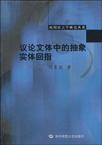议论文体中的抽象实体回指
2009-2
华中师范大学出版社
刘东虹
273
目前国内外对于回指的研究主要是名词性回指。不同的研究者从不同的角度对回指现象进行了研究,如句法、语义、语用、认知、心理以及人工智能。句法和语义研究主要集中在回指的句法和语义特征上。语言中的结构制约使得不同类型的名词性词语有不同的句法分布和语义解释。句法和语义研究者总是用简洁精确的形式阐述这些制约规则。此类研究的局限性在于仅仅分析句内回指,而实际上大多数回指表现在句与句之间,即篇章回指。其使用和理解受语用和认知因素的影响。语用和认知研究主要说明回指语类型的选择受篇章条件的制约,可能具有某些特殊的语用含义。这些研究只局限于回指语的使用方面,很少涉及回指语的理解以及语境对回指理解和篇章理解的作用。回指的心理研究和人工智能研究则侧重于回指的理解。 以上这些研究主要针对名词性回指,其研究结果无法适用于命题和概念做先行语的回指,即抽象实体回指。目前对于抽象实体回指的部分现象学者略有局部或零散的提及。如Chu(1998)区分了广义回指和狭义回指,把动词回指、副词回指和小句回指归入广义回指;许余龙(2002)给回指分类时也提到这种回指;Cornish(1986)和Webber(1988)也扼要地分析过句子回指;Kamp(1981)的“语篇表征理论(DRT)”从动态的角度研究抽象实体回指中的个别现象。不过这些学者只是在研究具体事物回指时偶尔提及属于抽象实体回指的一些现象,并未对此做过深入系统的研究。当前只有Asher(1993)提出的“语段表征理论(SDRT)”专门用于抽象实体的回指解决。
《议论文体中的抽象实体回指》的创新之处在确定了抽象实体回指是一种独立于其他回指的形式。将这种现象作为一种特殊类别的回指处理,研究其语用特征及理解规律,研究方式在采用实证与思辨的有机结合的基础上也有创新,不仅对英语中的抽象实体回指和具体事物回指进行定性与定量分析和比较,而且对汉语中的回指现象也进行了系统的分析比较,侧重思辨,辅以实证,并基于语料中对SDRT理论进行质疑与改进,提出新的解决办法。
序AcknowledgementsChapter 1 Introduction1.1 The Definition of Abstract Entity Anaphora1.2 Differences between Abstract Entity .Anaphora and Other Kinds of Anaphora1.2.1 Abstract Entity Anaphora and Concrete Individual Anaphora1.2.2 Abstract Entity Anaphora, Extended Reference and Text Reference1.2.3 Abstract Entity Anaphora and Deep Anaphora1.2.4 Abstract Entity Anaphora and Associative Anaphora1.3 The Necessity of the Study of Abstract Entity Anaphora in Argumentative Texts1.3.1 The Limitations of the Previous Study of Abstract Entity Anaphora1.3.2 Characteristics of Argumentative Text1.3.3 Argumentative Text and Abstract Entity Anaphora1.4 Research Purpose and Significance1.5 Organization of the StudyChapter 2 Pragmatic Features of Abstract Entity Anaphora2.1 Introduction2.2 The Written Argumentative Data2.2.1 The Sources of the Argumentative Texts2.2.2 The Criteria of Data Collection and the Content of Data Analyses2.2.2.1 The Criteria of the Data Collection2.2.2.1.1 Anaphors2.2.2.1.2 Antecedents2.2.2.2 The Content of Data Analyses2.3 Pragmatic Functions of Abstract Entity Anaphors2.3.1 Recapitulation2.3.2 Obscuration2.3.3 Demarcation2.4 Text Environment of Abstract Entity Anaphora2.4.1 Background2.4.2 Text Environment of English Abstract Entity Anaphora2.4.2.1 Ariel's Work on English Concrete Individual Anaphora2.4.2.2 The Present Study of English Abstract Entity Anaphora2.4.3 Text Environment of Chinese Abstract Entity Anaphora2.4.3.1 The Study of Chinese Concrete Individual Anaphora by 许余龙2.4.3.2 The Present Study of Chinese Abstract Entity Anaphora2.4.4 Comparisons between English and Chinese Abstract Entity Anaphora2.5 Pragmatic Tendency of Abstract Entity Anaphora2.6 Backwards Anaphora2.7 SummaryChapter 3 Discourse Structure and Discourse Anaphora3.1 Introduction3.2 Rhetorical Structure Theory (RST) by Mann and Thompson3.2.1 Main Idea3.2.2 Comment3.3 Rhetorical Structure by Fox3.3.1 Main Idea3.3.1.1 Basic Units3.3.1.2 Rhetorical Relations3.3.1.3 Anaphora3.3.2 Comment3.4 Linguistic Discourse Model (LDM) by Polanyi3.4.1 Main Idea3.4.2 Comment3.5 Other Related Studies3.6 Discourse Representation Theory3.6.1 Main Idea3.6.1.1 DRS Construction3.6.1.2 DRT and Anaphora Resolution3.6.2 Comment3.7 Taking StockChapter 4 SDRT and Abstract Entity Anaphora4.1 Introduction4.2 Discourse Relations and Topic4.2.1 Discourse Relations4.2.2 Topic4.3 SDRS Construction4.3.1 Determining the Basic Constituents4.3.2 Constraints on Possible Sites for Constituent Attachment4.3.3 SDRS Updating4.3.4 Constituent Revision4.4 SDRT and Abstract Entity Anaphora4.4.1 Constraints on Abstract Entity Anaphora4.4.2 AVAILABILITY and Constituent Revision4.4.2.1 AVAILABILITY and Topic Revision4.4.2.2 AVAILABILITY and Discourse Relation-based Revision4.4.3 More Application to Abstract Entity Anaphora4.4.3.1 Event and Propositional Anaphora4.4.3.2 Concept Anaphora4.4.3.3 Discourse Subordination4.5 Application of SDRT to Chinese Abstract Entity Anaphora4.6 SDRT and Backwards Anaphora4.7 Support from Cognitive Psychology4.7.1 Situation Model4.7.2 Resonance Model4.8 SummaryChapter 5 Inadequacies of SDRT and Suggested Solutions5.1 Introduction5.2 Inadequacies5.2.1 Discourse Relations5.2.2 Topic Construction5.2.3 The Role of the Topic5.2.4 Explicit Referent Identification5.2.5 Implicit Referent Identification5.2.6 Reference Ambiguity Resulting from Double Attachment Sites5.2.7 Long-distance Anaphora5.3 Suggested Solutions5.3.1 Simplification of the Discourse Relations in SDRT5.3.1.1 Background5.3.1.2 Proposed Categorization5.3.1.3 Effect of the Simplification5.3.2 Topic Construction of Binary Structures5.3.3 Topic Dominating Role5.3.4 Explicit Referent Interpretation5.3.4.1 Semantic Information in Anaphoric Sentence5.3.4.2 Semantic Information in the Sentences before the Anaphoric Sentence5.3.4.3 Semantic Information in the Anaphor5.3.5 Proposition Abstraction for Implicit Referent5.3.5.1 Indirectness, Inference and Proposition Abstraction5.3.5.2 Antecedent Types for Proposition Abstraction5.3.5.3 Triggers for Proposition Abstraction5.4 SummaryChapter 6 Processing of Reference Ambiguity and Long-distance Anaphora6.1 Introduction6.2 Solutions to Reference Ambiguity6.2.1 Context and Intension6.2.2 Tendency Investigation6.2.2.1 Background6.2.2.2 Processing Strategies in Three Types of Discourse6.2.2.3 Questionnaire and Procedure6.2.2.4 Results6.2.2.5 Discussion6.2.2.6 Conclusion6.3 Long-distance Anaphora6.3.1 Background6.3.2 Theoretical Bases6.3.2.1 Van Dijk's Superstructure6.3.2.2 Van Eemeren et al.'s Argumentation Structures and Reconstruction6.3.3 Hypothesis Formulation6.3.3.1 Proposed Superstructure of Argumentative Texts6.3.3.2 Hypothesis about the Resolution of Long-distance Anaphora6.3.4 Instances of Application6.3.4.1 Standpoint as the Antecedent6.3.4.2 Question or Background as the Antecedent6.3.4.3 Arguments as the Antecedents6.3.5 The Role of Semantic Chains in Referent Interpretation6.3.5.1 The Role of Semantic Chains6.3.5.2 Psychological Warrant6.4 SummaryChapter 7 Conclusion7.1 Achievements of This Study7.2 Limitations and Suggestions for Future ResearchAppendixBibliography
Chapter 1 Introduction 1.1 The Definition of Abstract Entity Anaphora Abstract entities originally fall into a philosophical category, yet they have linguistic aspects and are discussed by some linguists such as Lyons (1977), Asher (1993), Vendler (1967), Smith (2003) and Peterson (1997). But Lyons' abstract entities correspond only in part to the other linguists'. Lyons classifies entities in the world into three kinds. First-order entities are physical objects that are publicly observable, relatively constant as to their perceptual properties and located in a three-dimensional space. Second-order entities mean events, processes, state-of- affairs etc. that are said to occur or take place rather than to exist. They are observable and have a temporal duration. Third-order entities refer to such abstract entities as propositions which are outside space and time. The abstract entities proposed by Asher etal. cover not only third-order entities but also second-order entities. According to Asher (1993), abstract entities refer to propositions, concepts, facts and events, as can be seen in the following underlined parts.
